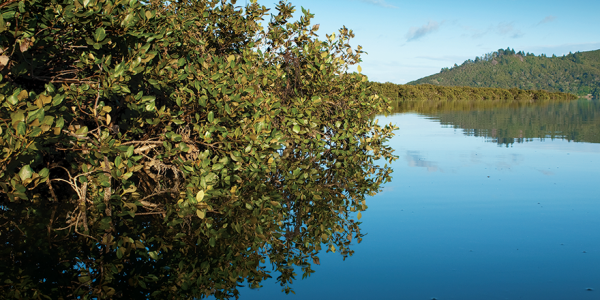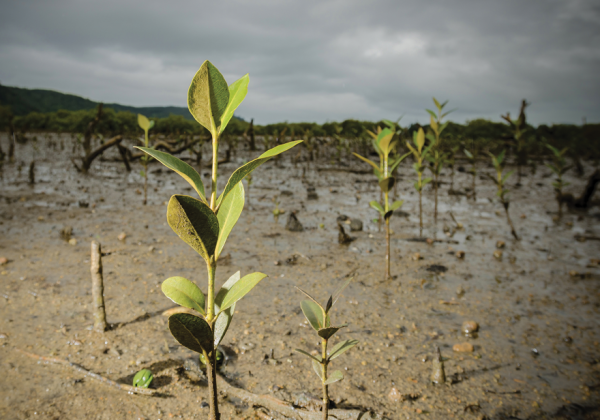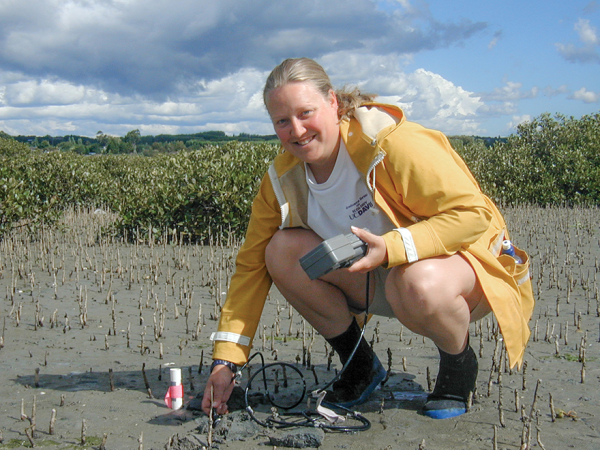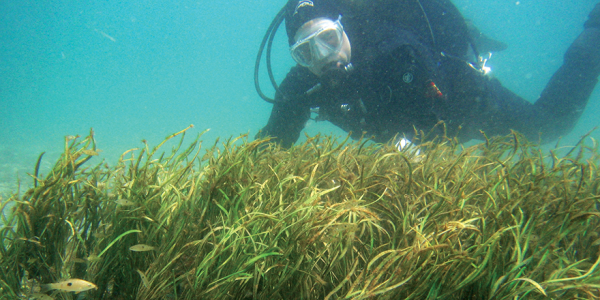New Zealand’s mangrove swamps and coastal marshes may be particularly adept at absorbing and storing the carbon we emit.
One of the newest fields of climate change studies is into what is being called “Blue Carbon”. This refers to the carbon captured in the marine environment, mainly by wetland vegetation (mangroves, salt marshes and seagrasses). Coastal wetland vegetation is found on every continent except Antarctica, covering the equivalent of 49 million hectares—an area about the size of Spain.
Their capacity for absorbing carbon is many times more than that of other ecosystems. Coastal vegetated habitats occupy just two per cent of the world’s seabed area, but are estimated to account for approximately 50 per cent of the carbon transfer to ocean sediments. The rate of carbon sequestration is estimated at up to 100 times faster in coastal vegetation than in terrestrial forests. Carbon sequestered by coastal vegetation can be stored for millennia if undisturbed.
This is good news for New Zealand, which is among the top 10 nations for longest coastlines. And it highlights a potential positive role for our often derided mangrove swamps, as well as from coastal marsh habitats which have historically been lost or degraded due to coastal development.
One of the most intriguing aspects of coastal carbon sinks is that as much as two-thirds of the carbon is stored not in the plants but in the soil. For example, New Zealand’s Avicennia marina mangrove swamps are estimated to store a total of about 120 tonnes of carbon per hectare in above—and below—ground biomass and soil to a depth of 100cm. Below-ground biomass and sediment contribute about 88 per cent of that total.
The study, headed by Dr Carolyn Lundquist, a Hamilton-based NIWA Principal Scientist in Marine Ecology, is monitoring the carbon (and nitrogen) stored in sediments in a suite of estuarine habitats. This is also complemented by NIWA strategic science funding research examining the “flux” (the release and absorption) of carbon from these zones using novel chambers on the seabed to capture and measure the carbon released from the sediment.
While the carbon-packing power of coastal environments could be a significant component in New Zealand’s carbon sink, Dr Lundquist says it’s too early to translate the results to a national scale.
“We have to know a lot more about variation between types of habitats. Initial results signal that saltmarsh and mangrove swamps store more carbon than other estuarine environments,” Dr Lundquist says.
“Total carbon storage is 5–10 times higher in saltmarsh habitats, and 2–3 times higher in mangrove forests, compared to mudflat habitats. While a lot has been made of seagrass carbon storage in global Blue Carbon research, the trial study suggests it is surprisingly similar to mudflat and sandflat habitats in New Zealand.”
So, is restoring coastal marshes a possible solution to help combat climate change? Dr Lundquist says more information is needed about carbon sequestration rates and storage across multiple habitats within estuaries.
“Blue carbon has the potential to contribute to New Zealand’s climate budget, but, as yet, our information is limited on the contribution of New Zealand coastal vegetation relative to global estimates.”
Many other countries are now more intensively studying Blue Carbon, and some programmes are examining restoration and sustainable use of coastal ecosystems as part of a climate change response (see The Blue Carbon Initiative).
NIWA plans further study to see if these patterns are consistent across multiple estuaries and for additional estuarine habitats and habitat quality.
Dr Lundquist is particularly keen to discover whether there are differences between the age, size and density of mangrove forest, and between different species of coastal marsh plants, because introduced species such as Spartina and saltwater Paspalum have invaded native marshes in some regions.
Dr Lundquist has a proposal pending to study multiple estuarine habitats, looking at how different restoration/management strategies change the resulting carbon storage and other ecosystem services provided by coastal vegetation. One of Dr Lundquist’s PhD students at the University of Auckland, Richard Bulmer, has examined carbon and nutrient cycling in New Zealand mangroves in his thesis research, primarily comparing intact and cleared mangrove sites.
“Coastal ecosystems contain a range of habitat types. Better understanding of the roles of all of these habitats, whether mangrove, coastal marsh, seagrass or mudflats, will help determine the role of these habitats in New Zealand’s response to climate change,” says Dr Lundquist.
Acid flux
Just as we’re discovering the carbon sink power of coastal environments, we’re also discovering their sensitivity to human impact and ocean acidification (see Water & Atmosphere, November 2015).
Globally, estuarine habitats have been harmed by direct and indirect consequences of aquaculture, agriculture, terrestrial and marine pollution and destruction by industrial and urban coastal development. There are some local examples, but no national data on habitat loss. For example, land development appears to have escalated silting in Whangamata Harbour over the past few decades, associated with an increase in mangroves and a decline in seagrasses.
Dr Lundquist says the impact of acidification on mangroves and seagrasses is also far from clear.
“Increasing carbon dioxide (CO₂) is expected to increase productivity through accelerated rates of photosynthesis, as for most plants. In overseas research, one species of mangrove, Rhizophora mangle, responded well to the doubling of CO₂ concentrations. It increased biomass, branching, leaf area, and maturation and reproduction, though these changes were also associated with decreases in plant nutritional quality.
“Environmental factors such as temperature, salinity and humidity are likely to have larger impacts than CO₂. So it is possible that there will be little or no change in mangrove production. In tropical regions with mangrove forests composed of many different species, community composition is likely to change due to species-specific responses to other factors associated with climate change.”
There are also global concerns for mangroves about responses such as advances in the time of flowering due to rising atmospheric CO₂, which increases the potential for desynchronisation with key pollinators. While little is known about mangrove pollination, this potential effect of climate change is being explored in terrestrial forests in New Zealand.
The acidification story for seagrasses is similarly mixed.
“Seagrasses tend to be carbon limited, and no one has yet observed changes in seagrass distribution or productivity due to increased CO₂ concentrations or due to the reduction in seawater pH,” Dr Lundquist says.
“Although seagrasses respond well to increased CO₂ enrichment, with increases in photosynthesis and growth, long-term exposure experiments are not conclusive. The reduction in pH projected this century is suggested to be unlikely to limit photosynthesis or counteract the effects of increasing CO₂ on seagrass growth.”
She points to field observations near volcanic seeps in Papua New Guinea, where pH varies from 8.1 to 7.8—comparable to the reduction expected over this century.
“Seagrass communities in the areas with lower pH and higher CO₂ concentrations had three to four times the shoot densities and below ground biomass, but reduced species diversity compared to areas with higher pH. It has been suggested that shallow water, dense and highly productive seagrass meadows could counter the effects of ocean acidification in localised areas and provide a buffer to calcifying organisms that occur within the seagrass beds or close by.”
The importance of this pH-contributing role in coastal areas is underlined by a recently-funded NIWA project in the Sustainable Seas National Science Challenge. The innovative plan by NIWA scientist Dr Cliff Law is to examine the effect on water chemistry of remediation efforts such as returning shells used by the shellfish industry to the seabed, and determining if the shell material can counteract ocean acidification.




